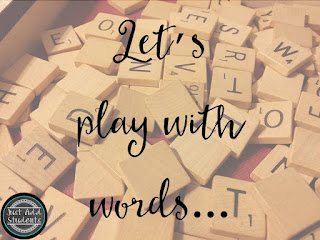In any
English classroom, there’s a lot of vocabulary that has to be covered
throughout the year. In addition to the
vocabulary from the stories and articles that you read, there is the vocabulary
that is specific to our subject – and there’s a lot of it! There are the story elements, poetry terms,
genres of reading, types of writing, figurative language terms, terms about
vocabulary itself, and more!
No matter
how you divide it among the different units that you teach, it’s a lot of terms
that your kids need to understand as they progress in their language arts
skills. The good thing is that, like
with other language arts elements, these literary terms tend to come up again and again
throughout the year so your kids will get a lot of chances to practice.
Story Elements
Characterization,
setting, plot, conflict, and theme. What
else? Maybe types of conflicts, plot elements, examples of themes – nearly
every main story element can be broken down into its own list of more literary
terms to teach!
But to me,
story elements are the easiest terms to teach because every story that you read
is a ready-to-use mentor text. Each time
your students complete a story map, plot map, or other story organizer they are
practicing using these terms.
Poetry Terms
You might
include types of poems here, or sound elements of poetry, or figurative
language, or maybe all three! Of course,
figurative language will fit just as well with fiction readings, and it can
also be found in non-fiction, although this may be more for the older
kids.
For types of
poetry, I like to have kids make a collection of their favorite poems of each
type, maybe by making a booklet with their own hand-written copies of the
poems, or a chart with a description of each poem and an illustration. Sound elements are fun to search for, too,
but can be a little difficult to find, so it might take a little time to set up
this lesson.
Genres of Reading
Genres of
fiction, genres of non-fiction, and oh yes, types of poems could be included
here too! My dilemma was always just which
genres, and how many, to include – any suggestions?
One thing
that comes to mind in this area is a library activity about finding different
types of books on the shelves, along with suggestions from your friendly
librarian for some good books in each genre.
Another idea would be to have the class, maybe one small group at a
time, sort through the classroom library and organize your books by genre.
Types of Writing
Once I
started to look at this group at a whole, the list turned out to be longer that
I had thought, too. Even a basic list
might include: narrative fiction,
narrative non-fiction, biography, autobiography, personal essay, descriptive,
informational, expository, explanatory, opinion, argument, and persuasive,
prose, and poetry.
But in addition
to these basic types of literature, kids also do plenty of daily writing, and
so do many adults, that is more in the form of lists, charts, forms, social
media comments, and writing combined with graphics. Maybe these types aren’t as necessary to teach,
but they could be used as a bridge into more sustained writing activities.
Figurative Language Terms
These are
the fun ones, but they’re not easy! How
many times have you had to remind a student of the difference between a simile
and a metaphor, or explain that all exaggerations aren’t automatically
hyperbole? And isn’t it fun to teach a
word like “onomatopoeia,” – who but an English teacher would even try?
The fun part
is when kids begin to really get the concept and appreciate the figurative
language in stories and poems that they read.
To introduce each literary term, find a few great examples that kids can
copy in their notebooks. It will help
them to remember the terms much better than just a definition. The example that
has stayed in my mind all these years for the term simile is a line from “Old Friends,” an old song by Paul Simon
about some elderly people passing the time by sitting in the park. These “Old friends, Sat on their park bench
Like bookends.”
Vocabulary Terms
Yes, there
are even terms about vocabulary itself that middle graders will still need to
learn. Connotation and denotation, for
example. And don’t you know of a few
kids who still get synonyms and antonyms mixes up? Many kids already know prefix, suffix, and
root, but how many of them know the term affix?
Altogether,
it’s a lot to teach. Oh well, English
teachers can handle it. Anyone who can
teach a term like “onomatopoeia” to middle grade kids can handle just about
anything!
I’ve found
it useful to have one big resource that I can go to as needed to introduce or
reinforce each little set of terms as needed, and so I’ve collected all of my
little bits and pieces of literary terms information and combined them into one
big, organized PowerPoint presentation.
Literary Terms includes definitions and
examples for 77 literary terms, and it includes student review slides at the
end of each section as well as student note pages to print out with definitions
for all 77 terms. Check out the preview
for more details if you think this is something that might be useful to you.

I would be
interested in hearing which literary terms teachers at various middle school
grades include. Are there any categories
that I could add to my lists? Or any
that don’t seem necessary? Click on the
comments below and let me know what you think.
Pin to save for later:
Blog post by Sharon from
Classroom in the Middle where you can read more about teaching language arts topics like reading skills, the writing process, and vocabulary in the middle grades,




















